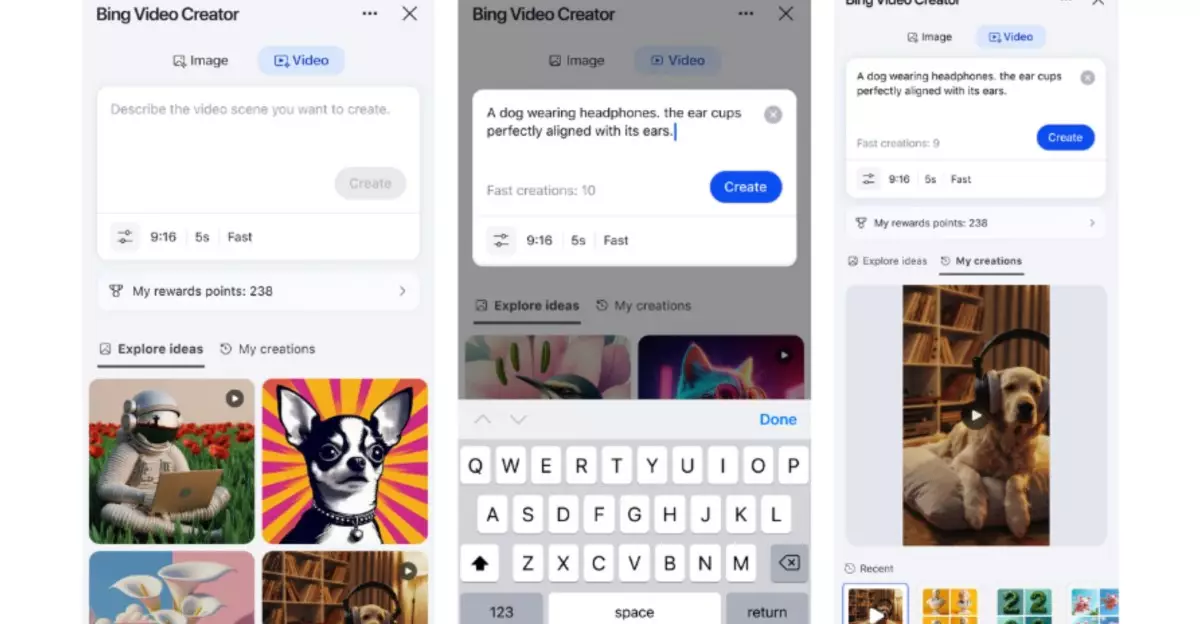In a world where content is king, the emergence of artificial intelligence (AI) in video generation marks a significant turning point in how we create and consume media. The latest innovation from Microsoft, the AI video generator integrated into the Bing mobile application, is paving the way for a new era of accessible creativity. Built on OpenAI’s Sora text-to-video model, this tool not only democratizes video creation but also challenges the dominance of traditional content production methods. It allows anyone with a smartphone to transform textual ideas into vivid video clips, changing the game for hobbyists and professionals alike.
Cost-Effective Solutions for Creative Expression
Historically, high-quality video production required specialized knowledge and substantial financial investment. However, Microsoft’s Bing Video Creator offers an enticing alternative by eliminating the hefty price tag typically associated with advanced AI tools. By integrating the Sora model, Microsoft makes it possible to generate engaging five-second clips for free, countering the norm that relegates sophisticated technology to those with deep pockets. The company states that their mission is to make creativity accessible to all, a sentiment that resonates deeply in a mass media landscape increasingly reliant on user-generated content.
With the infrastructure to create these videos embedded within an app that countless users already have on their devices, the barrier to entry for aspiring content creators is drastically lowered. By offering features like a choice between a standard or fast generation speed, Microsoft caters to both casual users and those who may need quicker turnaround times for their content.
Ease of Use and Accessibility
The Bing Video Creator stands out for its user-friendly interface. Users simply input a description of the desired clip into the search bar or navigate through the app menu, fostering a smooth and intuitive experience. This ease of use extends beyond the app itself; with support for both Android and iPhone, as well as forthcoming desktop access, Microsoft ensures that content creation can happen anywhere, anytime. The integration of a notification system that informs users when their video is ready further enhances the user experience, allowing creators to engage with their projects without unnecessary delays.
While the technology runs under the hood might be intricate, the process for users feels fluid and uncomplicated—the hallmark of a well-designed product. However, as with any new technology, the effectiveness of self-expression does depend on the users’ ability to adapt and explore the capabilities of the AI, fostering a new level of digital literacy among a diverse user base.
Quality Concerns and Future Potential
Despite its groundbreaking approach, the output quality of the Bing Video Creator has raised eyebrows. Early examples of its video creations reveal a distinct difference when compared to existing high-end AI video tools like Google’s Veo 3. Issues such as unnatural movements and a cartoonish appearance have emerged in Microsoft’s content demos, reflecting an important point of discussion: while the technology is accessible, it may not yet match the high standards set by more established platforms.
This raises questions about the balance between accessibility and quality. Are consumers willing to sacrifice some quality for the sake of ease and cost? Will this initial offering improve as the technology matures? Users may ultimately find themselves weighing the creative freedom offered by Bing against the polished perfection of more sophisticated alternatives as they explore what this new tool can achieve.
The Democratization of Creativity
The introduction of the Bing Video Creator encapsulates a larger trend towards democratising creativity across the digital landscape. As tools become more accessible and user-friendly, we could witness a surge in diverse forms of artistic expression previously limited to those with specific skills or resources. The ability to create short, engaging videos could empower a new wave of storytellers and content creators, transforming the narrative around content creation in an increasingly visual world.
Overall, Microsoft’s latest initiative appears to be a significant advancement in bringing AI-powered creativity to the masses. As we embrace this new technology and navigate its imperfections, the true potential of AI in the creative realm becomes tantalizingly apparent, promising an exhilarating future for content creation.


Leave a Reply